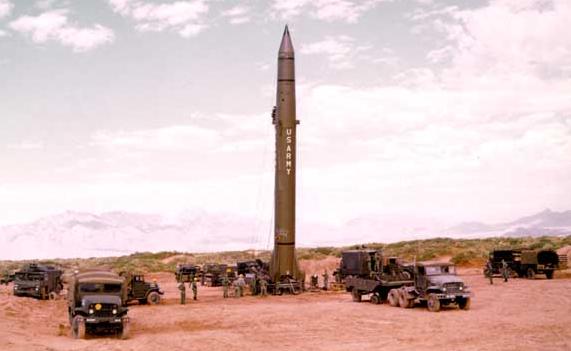Chrysler SSM-A-14/M8/PGM-11 Redstone
The Redstone was the U.S. Army's first operational MRBM (Medium Range Ballistic Missile). Although its service life as a weapon was relatively short, it played a major role in the early American space program.
In November 1944, the Army contracted General Electric to study and develop long-range guided missiles under the general name of Hermes. The Hermes program consisted of many different projects (for details on all Hermes projects, see article on SSM-A-16 Hermes A-3B), and also included the Hermes C-1 for a ballistic surface-to-surface missile in the 800 km (500 miles) range class. However, because of limited funding and higher priority assigned to other Hermes projects, progress on the C1 was slow. This changed in 1950, when the Korean War led to a sharp increase in military spending, and responsibility for the Hermes C-1 project was transferred from G.E. to the Army's Guided Missile Center. At that time, the formal designation of SSM-G-14 was assigned to the Hermes C-1 missile. In early 1951, the payload requirements for the missile were significantly increased, reducing the planned range to 400 km (250 miles). Im mid-1951, the program was transferred again, to the Army's Redstone Arsenal, and the missile designator was changed to SSM-A-14. It was not until April 1952, that the name Redstone was officially assigned, after the names Ursa and Major had also been used briefly.
Major design work on the Redstone was finished during 1952, and in October that year, Chrysler received a contract for production of the missile. The SSM-A-14 incorporated some firsts in missile technology, like an all-inertial guidance system. and a separable warhead section to reduce drag (and thereby increase range) during reentry. It used a single North American Rocketdyne NAA75-110 liquid-fueled rocket engine (also known as A-6), a development of the XLR43-NA-1 engine. In August 1953, the first successful flight of an XSSM-A-14 occurred, and in 1955, Chrysler began the production of Redstone missiles. Many Redstone test missiles were converted to Jupiter A and Jupiter C test missiles to support the SM-78/PGM-19 Jupiter IRBM program. The first production missile flew in July 1956, and by June 1958, the first fully operational Redstone unit had been deployed to West Germany. By that time, the designation Guided Missile, Field Artillery, M8 had been assigned to the Redstone. Non-flying dummy missiles used as trainers were designated XM9.
 |
| Photo: U.S. Army |
| M8 (PGM-11A) |
The Redstone was a capable MRBM, which could lift its 4 MT W-39 thermonuclear warhead to a range of 325 km (175 nm) with an accuracy of about 300 m (1000 ft) CEP. Howerver, a Redstone battalion was very cumbersome to move, consisting of almost 20 heavy vehicles. When a launch site was reached, its exact position had to be determined, the launch pad had to be leveled, and the three sections of the missile had to be assembled and erected. All this took more than 8 hours to complete. After receiving the launch order, fueling would need another 15 minutes, before the Redstone could finally be launched.
In June 1963, the M8 and XM9 missiles were redesignated as PGM-11A and PTM-11B, respectively. At that time, phase-out of the Redstone had already begun, and in late 1964, the PGM-11 was no longer in U.S. Army service. The Redstone was replaced by the much more advanced and far easier to use solid-fueled MGM-31 Pershing MRBM. In total, about 120 Redstone missiles were produced by Chrysler between 1955 and 1960.
 |
| Photo: U.S. Army |
| M8 (PGM-11A) |
The Redstone was an important rocket in the early U.S. space program. It formed the base of the Juno I, which was the launcher for the first American satellite, and it was used in the very important Mercury-Redstone program of suborbital flights, which led directly to the first U.S. manned orbital space flight with a Mercury-Atlas rocket.
Specifications
Note: Data given by several sources show slight variations. Figures given below may therefore be inaccurate!
Data for PGM-11A:
| Length | 21.1 m (69 ft 4 in) |
| Finspan | 3.66 m (12 ft) |
| Diameter | 1.78 m (70 in) |
| Weight | 27800 kg (61300 lb) |
| Speed | Mach 5.5 |
| Ceiling | 92 km (57 miles) |
| Range | 325 km (175 miles) |
| Propulsion | North American Rocketdyne NAA75-100 (A-6) liquid-fueled rocket; 347 kN (78000 lb) |
| Warhead | W-39 thermonuclear (4 MT) |
Main Sources
[1] James N. Gibson: "Nuclear Weapons of the United States", Schiffer Publishing Ltd, 1996
[2] Bill Gunston: "The Illustrated Encyclopedia of Rockets and Missiles", Salamander Books Ltd, 1979
[3] Redstone Arsenal Historical Information Website
Back to Current Designations Of U.S. Unmanned Military Aerospace Vehicles
Back to Directory of U.S. Military Rockets and Missiles
Last Updated: 22 January 2002